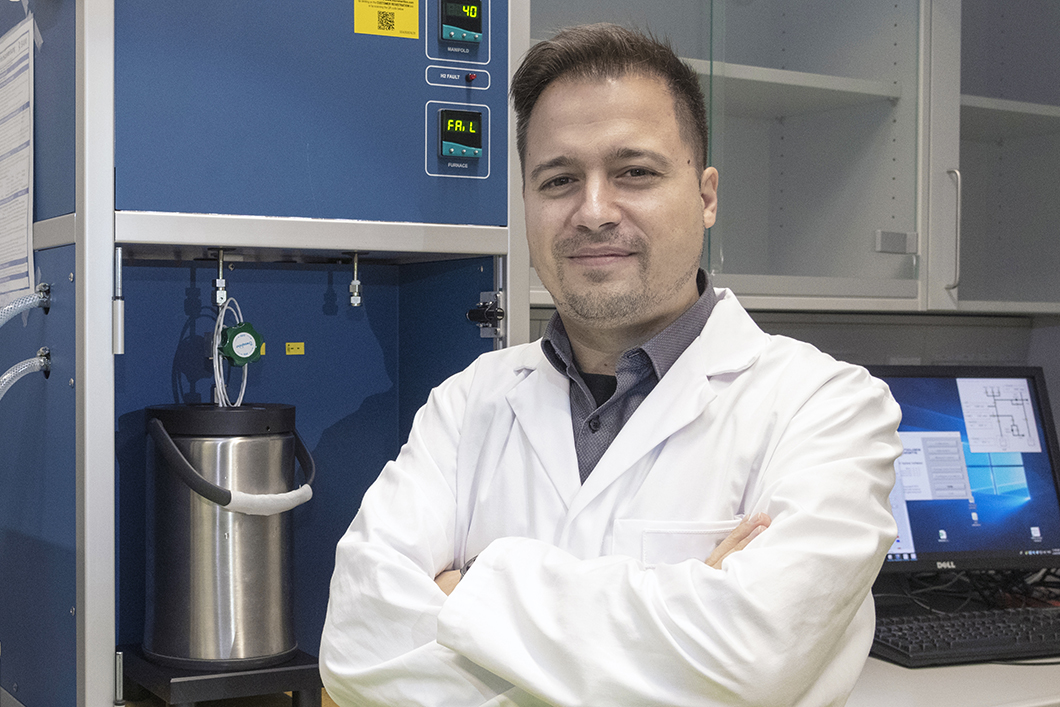
Dr. José Antonio Villajos Collado, Process Analytical Technology Division
Source: BAM
Interview series "Introducing People@BAM"
Dr. José Antonio Villajos Collado, Process Analytical Technology Division
José, tell us a little bit about yourself. What did you do in "your life before BAM"?
I am a chemical engineer from the King Juan Carlos University in Madrid, where I started my scientific activities investigating porous materials as catalysts or gas-adsorbers. Firstly, I studied mesostructured organosilica materials for fine-chemical applications. I got my Ph.D. in 2017 in hydrogen storage in Metal-Organic Framework materials by physical adsorption in the same university, where I learned about the synthesis, characterization, and use of these materials. During my Ph.D., I was also a guest in the Max-Plank Institute for Intelligent Systems, where I learned the good measurement practices for hydrogen adsorption in porous materials I use now at BAM.
What does your research focus on, and what excites you most about this topic?
My research is about the practical use of porous materials for hydrogen storage by adsorption in large-scale storage facilities. The benefits of adsorption are the possibility of reversibly store hydrogen at higher density and lower pressure than state-of-the-art compressed gas cylinders, also involving similarly fast charge and release kinetics. The limitations are the use of cryogenic temperatures and the cost of the needed porous materials, still expensive to produce even on a large scale. The best-performing materials for this porpoise are metal-organic frameworks (MOFs) which are, in general, highly costing due to their synthesis procedures and building blocks.
My research activities are focused on estimating the MOFs' performance from their porous properties, the selection amongst the several-thousand candidates from their building blocks, and the study of alternative and cheaper synthetic procedures for their industrial production. This work is exciting because hydrogen is a hot topic for research in Europe, while new and more efficient storage solutions are necessary. Besides, MOFs are promising materials for many potential applications, like catalysis, sensing, storage, capturing or separation of gases, biomedical applications, and others. Advances in their affordable production can benefit different activity fields in the industry and life.
Why research at BAM? What do you like most about your work here?
The use of adsorbents for hydrogen storage is not new. However, the reproducibility of some scientific results is low, which hampers the development of related technology. Although reproducibility of scientific results is successful if good measurement practices are used, reference materials and standard procedures are still necessary to facilitate the work for non-experts. This might also promote the industrial interest in adsorption as a solution for hydrogen storage. Standardization and safety are some of BAM's missions, and it is well situated between academia and industry. For this reason, BAM is an excellent place to develop reference data and procedures for the implementation of new technologies, like the hydrogen economy is.
Hydrogen is present in BAM's strategy (H2Safety@BAM), where the "Kompetenzfeld" MatCom organizes activities about the study of properties and compatibility of the used materials in hydrogen production, transport, storage, and distribution. Into it, MatCom4 considers the activities about hydrogen storage in materials, currently including my previous and present work in porous materials for physical adsorption, but open to studying chemically-based systems like metallic or liquid hydrides in the future.
What would you like to do when you're not doing research?
I would like to contribute to establishing hydrogen technologies for a sustainable energy system in the course of my professional life. I hope I can enjoy my retirement on the beach after it.
If you should describe your job at BAM in one sentence – what would that be?
Feasibility of hydrogen storage in solid materials by sorption mechanisms.


